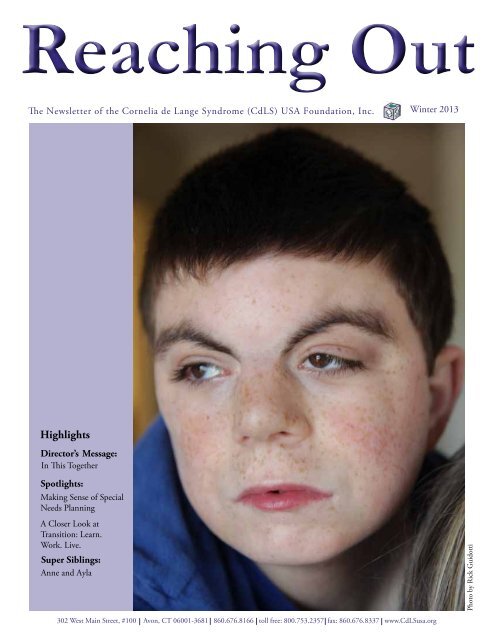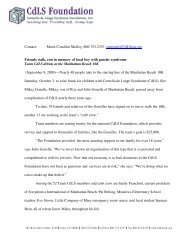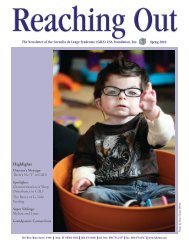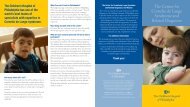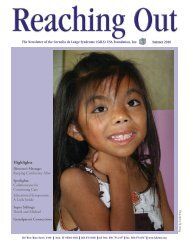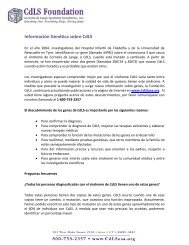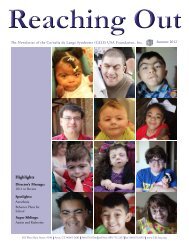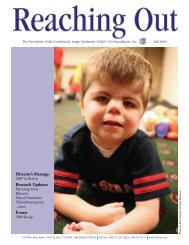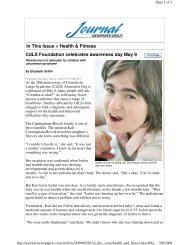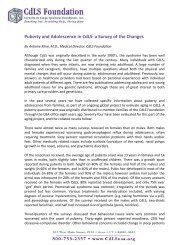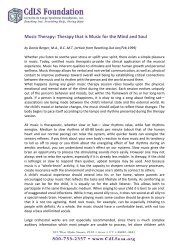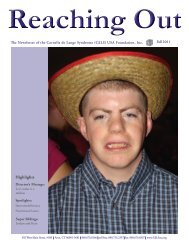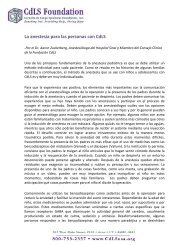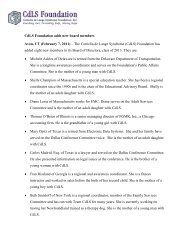Winter 2013: Making Sense of Special Needs Planning & A ... - CdLS
Winter 2013: Making Sense of Special Needs Planning & A ... - CdLS
Winter 2013: Making Sense of Special Needs Planning & A ... - CdLS
- No tags were found...
Create successful ePaper yourself
Turn your PDF publications into a flip-book with our unique Google optimized e-Paper software.
Reaching OutThe Newsletter <strong>of</strong> the Cornelia de Lange Syndrome (<strong>CdLS</strong>) USA Foundation, Inc.<strong>Winter</strong> <strong>2013</strong>HighlightsDirector’s Message:In This TogetherSpotlights:<strong>Making</strong> <strong>Sense</strong> <strong>of</strong> <strong>Special</strong><strong>Needs</strong> <strong>Planning</strong>A Closer Look atTransition: Learn.Work. Live.Super Siblings:Anne and AylaPhoto by Rick Guidotti302 West Main Street, #100 Avon, CT 06001-3681 860.676.8166 toll free: 800.753.2357 fax: 860.676.8337 www.<strong>CdLS</strong>usa.org
Benefits <strong>of</strong> the Multidisciplinary Aging ClinicsBy Antonie Kline, M.D., <strong>CdLS</strong> Foundation Medical DirectorSince this Reaching Out concentrates on several <strong>of</strong> theissues facing older individuals with <strong>CdLS</strong>, it seemedfitting to talk about the <strong>CdLS</strong> Multidisciplinary Clinicfor Adolescents and Adults, held at the Greater BaltimoreMedical Center.We are in our twelfth year <strong>of</strong> <strong>of</strong>fering the twice yearlyclinic for individuals 12 years <strong>of</strong> age and older. The clinic ismultidisciplinary, which means that providers from manydifferent specialties (gynecology, ophthalmology, behavior, etc.) volunteer theirtime to see each family and make recommendations. It is also helpful becausethe pr<strong>of</strong>essionals can discuss various aspects <strong>of</strong> care in <strong>CdLS</strong> with each other tothe benefit <strong>of</strong> the patients.Each clinic is unique, but the families always have a bond by the end <strong>of</strong> the day.The clinic held most recently happened to involve only females in their 20s and30s, so immediately there was a connection. The parents <strong>of</strong> similarly involveddaughters were able to exchange experiences and make recommendations to eachother. One <strong>of</strong> the highlights was that several <strong>of</strong> the young women interacted,sharing mutual likes, dislikes and complaints.At another clinic, two families planned to explore part <strong>of</strong> the Inner Harbor inBaltimore together, and a third family was staying downtown in order to takeadvantage <strong>of</strong> the city. Another time two families met ahead <strong>of</strong> time by stayingin the same hotel and were able to dine together and share stories before clinic.Although the goals <strong>of</strong> this clinic are primarily for individuals to be evaluated byexperts in <strong>CdLS</strong>, receive recommendations and assess the aging process in <strong>CdLS</strong>,they include shared experience with other families in similar situations. If theseinteractions continue after the clinic has passed, all the better.I constantly marvel at the dedication <strong>of</strong> the volunteers who have been attendingthe clinics year after year. They truly go out <strong>of</strong> their way to help these families.It is always so gratifying to be involved in the whole experience, and I thank all<strong>of</strong> the participants from the bottom <strong>of</strong> my heart.Reaching OutPublished Since 1977(ISSN 1097-3052)Cornelia de Lange SyndromeFoundation, Inc.Incorporated December 1981email: info@<strong>CdLS</strong>usa.orgwww.<strong>CdLS</strong>usa.orgBoard <strong>of</strong> DirectorsPresident. .........Marc Needlman, ILVice Presidents.. . . . . . . . . . . . . . . . . . .. . . . . . . . Eileen Ahearn, M.D., Ph.D., WI. . . . . . . . . . . . Robert Boneberg, Esq., NJ. .Kari Cunningham-Rosvik, A.P.R.N, WATreasurer ........ Thomas O’Brien, ILSecretary. ........... Garth Black, PADirectors. .... Michele Churchman, DE.. . . . . . . . . . . . David Barnes, Esq., NH. . . . . . . . . . . . . . . .Shelly Champion, MA. . . . . . . . . . . . . . . . .Catherine Caron, NH. . . . . . . . . . . Richard Haaland, Ph.D., GA. . . . . . . . . . . . . . . . . . . David Harvey, GA. . . . . . . . . . . . . . . . . . . Dianne Lessa, MA. . . . . . . . . . . . . . . . . Maegan Lowrey, NC. . . . . . . . . . . . . . Carlos Madrid, Esq., TX. . . . . . . . . . . . . . .Wendy Miller, Esq., CA. . . . . . . . . . . . . . . . . . . . . Mary Opitz, TX. . . . . . . . . . . .Julia O’Connor, Ph.D., MD. . . . . . . . . . . . . . . . . . . Fran Rissland, GA. . . . . . . . . . . . . . . . . . . Beth Smisl<strong>of</strong>f, NYPr<strong>of</strong>essional staFFExecutive DirectorMarie Concklin-MalloyMedical DirectorAntonie Kline, M.D.Assistant Executive DirectorKelly BrownDevelopment ManagerGail SpeersFamily Service ManagerDeirdre Summa, M.S.W.Family Service coordinatorsLynn Audette, M.S.W.Kelly Madin, M.A., LMFTGraphic Designer/web masterFrancesca ScognamiglioThe next clinics are Saturday, April 13 and Saturday, November 9. Contact DeirdreSumma at 800.753.2357 for more information or to sign up.Welcome New Members to Board <strong>of</strong> DirectorsJulia O’Connor, Ph.D., is director <strong>of</strong> Day Treatment Services for the Neurobehavioral Unit atthe Kennedy Krieger Institute in Baltimore, MD, and serves as co-chair <strong>of</strong> the Foundation’sPr<strong>of</strong>essional Development Committee.Maegan Lowrey, <strong>of</strong> Greensboro, NC, is the first person with <strong>CdLS</strong> to join the Board. Maegan isa self-advocate and an artist and studied visual arts at Barton College.1.800.753.2357Communications CoordinatorBrenda ShepardDevelopment CoordinatorKellie German SantiagoOffice CoordinatorKate PomainvilleAll information contained herein is for thereader’s personal interest. Articles on treatments,medications, or procedures, etc. are not guides forself-treatment. Questions should be discussed withyour doctor or other appropriate pr<strong>of</strong>essionals. The<strong>CdLS</strong> Foundation does not endorse any productadvertised and/or mentioned in Reaching Out.3 <strong>Winter</strong> <strong>2013</strong>
<strong>Making</strong> <strong>Sense</strong> <strong>of</strong> <strong>Special</strong><strong>Needs</strong> <strong>Planning</strong>By Protected Tomorrows, Inc.If you are a parent <strong>of</strong>a child with specialneeds, governmentbenefits and legaloptions are <strong>of</strong>tenconfusing. We <strong>of</strong>tenhear families say thattheir family memberis not eligible for benefits, or that everyone is turned downthe first time they apply. We also hear that in order fora person with a disability to receive benefits, the parentsmust disinherit the child in their will. Both <strong>of</strong> thesestatements are not true.Here is a brief explanation <strong>of</strong> government benefits thatyour child may or may not become eligible for, but youmay want to investigate:• SSI – Supplemental Security Income – A federalincome supplement program funded by general taxrevenues (not Social Security taxes). Its purpose is tohelp the aged, blind and disabled who have little or noincome. It currently provides a maximum <strong>of</strong> $698 permonth to be used for basic needs such as food, clothingand shelter. This amount will increase to $710 permonth in <strong>2013</strong>. It is generally for people who havelittle or no work history. An SSI applicant must limittheir assets in order to qualify for this benefit. Basically,the allowable assets for a person applying for SSI area home, one car, a pre-paid funeral, and $2,000. Ofcourse, understanding what is considered an asset isimportant, as well as which is the appropriate asset foryour family member to own.• SSDI – Social Security Disability Insurance – Afederal cash benefit program that may be available ifa person is disabled. It pays benefits to the individualand certain members <strong>of</strong> the individual’s family if youare “insured” meaning that you worked long enoughand paid Social Security taxes. Each insured individualshould receive a statement from Social Securityexplaining their status <strong>of</strong> eligibility. Social Securitystatements can also be obtained from http://www.ssa.gov/mystatement/.Reaching Out4• Medicare – A federal health insurance program forpeople 65 years <strong>of</strong> age or older, certain younger peoplewith disabilities, and people with End-Stage RenalDisease (permanent kidney failure with dialysis or atransplant). Medicare does not cover everything, and itdoes not pay the total cost for most services or suppliesthat are covered.• Medicaid – A state run medical assistance programfor certain individuals and families with low incomesand resources. Medicaid eligibility is limited toindividuals who fall into specific categories. Althoughthe Federal government establishes general guidelinesfor the program, the Medicaid program eligibilityrequirements are actually established by each State.In addition to paying for some medical services andprescriptions, Medicaid may also pay for residentialfacilities, workshops and other programs. This programhas asset limitations similar to the SSI limitations.When planning for your family member, it is important tobuild a life plan. This involves understanding your dreamsfor your child’s future, and recognizing the fears you havefor them as well. The next step is to identify how thosedreams can be built upon and the fears can be mitigatedas you build a future plan for your child.It’s important to evaluate your child’s entire picture andtake a few more things into consideration:• Although you may be dealing with a child at this time,what do you see for him/her in the future? Supportedemployment? Workshop employment? Residentialliving?• Does your existing health insurance remain in effectwhen your child turns 26?• What assets are presently in his or her name? Example:savings bonds, life insurance, stocks, mutual funds,homes, etc.• Is there a possibility <strong>of</strong> inheriting any money or assets?Once you’ve answered these questions, you can then lookat what benefits he/she may be eligible to receive and howto best position his/her assets and income.Often parents ask, is there a way I can leave an inheritanceContinued on page 12www.<strong>CdLS</strong>usa.org
A Closer Look at Transition:Learn.Work.Live.Heading <strong>of</strong>f toCollegePreparing for the transitionfrom high school to postsecondaryeducation is atremendous milestone foranyone. For those with<strong>CdLS</strong>, as well as their familymembers, this transitionmay come with unexpectedchallenges. It may alsobe very rewarding andgratifying experience. Emily (pictured left), a 20-yearoldfrom Alabama, who has finished her first semester incollege in December, also has <strong>CdLS</strong>. Her mother, Sandra,shared her experiences preparing Emily for college andEmily’s experiences during the first months in school.to take ownership <strong>of</strong> this process. She currently receivesextra time for test taking, can take tests in their <strong>of</strong>fice, andreceives study notes taken by a school-provided note taker.We started early in Emily’s education preparing her toadvocate for herself, so she’s really good about that. Whentransition services started at age 14, we made sure Emilyknew what her IEP said and prompted her to use heraccommodations, but we tried not to let her use her IEPas a crutch. Emily has always been driven by an intrinsicPreparing for Emily’s transition:Exploring college choices was part <strong>of</strong> Emily’s IndividualizedEducation Plan (IEP) transition services goals. Emilyinitially wanted to attend a larger school, further fromhome, but we encouraged her to visit other schools. Ifelt she needed to be in a smaller environment to succeed.Emily ultimately decided where to attend. In most otherways, it was just like preparing my other daughter forcollege: lots <strong>of</strong> college visits, applications essays, entrancetesting, etc.Emily had to take the American College Testing (ACT)Exam test three times before she scored high enoughfor admittance. She scored enough on her first test forconditional acceptance (which meant fewer class hours,monitoring, etc.), but she was determined to score highenough for unconditional acceptance.About Emily’s resources:The university Emily is attending has a disability support<strong>of</strong>fice, which has been a great resource. We met with thecoordinator at one <strong>of</strong> Emily’s first visits and kept in touchwith her throughout the process. I let Emily handle all<strong>of</strong> the discussions with their <strong>of</strong>fice (though I was thereif needed) because I thought it was important for Emily1.800.753.2357desire to succeed with as little help as possible.All public universities and many private schools havesome form <strong>of</strong> disability support. As parents, we don’t havemany rights once our kids enter college because they areconsidered adults, so it’s important for the kids to knowwhere to go for help, and to be comfortable accessing thathelp when needed.About the transition:The most difficult part <strong>of</strong> this transition for me was lettinggo <strong>of</strong> the control I’ve always had. Emily had participatedin week-long youth camps held at college campuses awayfrom home. These helped prepare her for college life, butshe said leaving home was the most difficult part for her.Though she did have some difficulty passing the ACTtesting requirements, she could’ve gone to a junior collegefirst if she had not scored high enough.About Emily’s first semester:Emily is majoring in education and wants to be a specialeducation teacher. I’m a teacher, her aunt is a teacher, andher grandmother was a teacher, so it made sense to Emily.Continued on page 135 <strong>Winter</strong> <strong>2013</strong>
Begin the Vocational Journey with theEnd in MindOnce school has ended for those with <strong>CdLS</strong>, a whole newset <strong>of</strong> adventures awaits. Whether it’s volunteering at a localbusiness, attending social events in the community or evenworking in a bakery, transitioning out <strong>of</strong> school and intothe community can be a wonderful experience if vocationalfoundations are laid well. Molly, mother <strong>of</strong> Alex (picturedwith his sister below), shares her experience in preparing Alexfor this transition.services always allowed him to address as many functionalskills as possible in real-life settings, while at the same timepermitting interaction with non-disabled peers.The journey truly began with the end in mind. We haveused tools and strategies that helped us dream for ourson, from a very young age, and put into words the visionour family has for his future. It allowed us to look at thepossibilities, not his disability. We planned, adjusted, andplanned again and again. Each change included writtendocumentation <strong>of</strong> the vision developed by the people whohave known and loved him best.It is important to remember that despite his successes andaccomplishments beyond high school, Alex requires oneon-onesupport to complete his tasks. Despite the level<strong>of</strong> support required, community inclusion is obtainable.We continue to surround our family with good peoplewho support our vision. We have chosen paths at timesthat required some “trailblazing” because they were lesstraveled. The process over time has included the following:Transitioning from school age services to adulthoodservices is an excursion <strong>of</strong> potholes, bumps and smoothpavement, depending upon any given day, hour orminute.The process for our son, Alex, who is now 21, beganformally around the age <strong>of</strong> 14, as Pennsylvania lawrequires families and schools to begin addressing transitionage goals in the Individualized Education Program (IEP)at this age. Those goals must address employment,independent living, and post-secondary goals.Truthfully, we have been planning for a “life” allalong. Alex’s educational services could be describedas a modified curriculum, based on life skills, withparticipation in the general education classroom. TheseReaching Out61. Continuous planning for a future that includes work,recreation and socialization in the community as a drivingforce, and never losing sight <strong>of</strong> that end. We wouldrevisit the dream many times throughout Alex’s schoolyears through Person Centered <strong>Planning</strong>, <strong>Making</strong> ActionPlans (MAPS) and <strong>Planning</strong> Alternative Tomorrow’s withHope (PATH) and monthly collaboration meetings fromsixth grade through graduation. “A person centered plancan help those involved with the focus person see thetotal person, recognize his or her desires and interests,and discover completely new ways <strong>of</strong> thinking about thefuture <strong>of</strong> the person.” 12. Collaborative team members are necessary and thesemembers have included people who respect our vision orshare our vision, including: parents, special educationteachers, general education teachers, occupationaltherapy, physical therapy, Teacher <strong>of</strong> the Visually Impaired(TVI), speech therapist, hearing consultant, deaf-blindconsultant, and local education agency representatives.When the timing was right, Office <strong>of</strong> VocationalRehabilitation and Bureau <strong>of</strong> Blind and Visual Servicesrepresentatives were invited to join the team. Our schooldistrict also hired a vocational consultant to join the teamduring Alex’s last two years in the school system.Continued on page 13www.<strong>CdLS</strong>usa.org
Home is Where the Heart Is1.800.753.2357For people with <strong>CdLS</strong>,a major transition is oneinto different housing, andnavigating funding forthe future. After dealingwith a mixture <strong>of</strong> livingmodels and confrontingvarious financial barriers,Jan and James share theirexperience with planningthis transition for their son,Gregg (pictured left).Until our son, Gregg,turned 18, there were few changes in his life with us,except for different school situations. Once he turned18, we filed for legal guardianship and were able to enrollhim in our state (New Mexico) Medicaid waiver. Hecontinued in school until age 22, while still living withus. Gregg is now 47 years old.A new group home opened around the same time thathe could no longer go to school. We wanted to be surehe could be independent <strong>of</strong> us, so he moved to the grouphome with the Medicaid waiver funding. At the time,we felt group homes were the best answer to assure hiscare and independence, while still having the ability tomonitor him.After six years, New Mexico stopped funding grouphomes and institutions, and placed the people inindependent living situations within the community.Most people lived in rentals, with staff there on a fulltimebasis to care for them. Generally, the rentals werepaid by the residents from their Social Security incomeand were at the low-cost end <strong>of</strong> the rental market. Thismeant they were not always the best houses or landlords,so changes <strong>of</strong> residence were common. We did not wantthis to happen, so we purchased a home in 1996, whereGregg and one other client live and pay rent still today.It was initially a supported living model, staffed bypeople working eight-hour shifts. While we monitoredthe situation and caregiver staff carefully, there werealways problems having different people providing careat different times. The pay for caregivers was not high, sothe turnover in personnel was frequent as well.We changed to a home-based care model, where thecaregiver does not change and lives in Gregg’s home. Manyclients live in homes owned by the caregiver. In our case,the caregiver resides in Gregg’s house full time and receivesa salary. We do not charge the caregiver rent or utilities,and she has 700 to 1,000 hours <strong>of</strong> respite time <strong>of</strong>f.Gregg gets out <strong>of</strong> the house daily through a “day-hab”program three days per week or doing volunteer work. Hevolunteers at our church every Saturday for five hours aswell. He also goes to the gym three days per week to workon flexibility, which has become a problem as he ages.<strong>Planning</strong> AheadAt one point, we funded a Supplemental <strong>Needs</strong> Trust toprovide money for Gregg’s brother to obtain the extrathings Gregg might need that are not funded under theMedicaid waiver. We didn’t spend any <strong>of</strong> the funds inthe trust, but found the tax filings and reports were moreeffort than it was worth.A <strong>Special</strong> <strong>Needs</strong> Trust wasn’t too expensive in our case,though it could be for some families. The problem is thatagencies that monitored Gregg’s program really didn’tunderstand what it was. Gregg had no access to thismoney, only we did. They would hear the word “trust”and think he had money stashed away. It took a lot <strong>of</strong>explaining so we stopped bothering to mention it.We now have a Family Trust, <strong>of</strong> which Gregg’s brotheris the recipient and executor. Gregg has no access tothis trust, but we’ve included a letter <strong>of</strong> intent, which isupdated periodically concerning Gregg. In this letter, wedescribe Gregg, his medical information, his personalneeds, his likes and dislikes, his living arrangements, andour concern for his welfare in the future. As Gregg ages,care giving and living arrangements change and thereforeinformation has to be updated as well.For now Gregg’s situation is stable, with his care assuredwhen we are gone. However, programs change, andcertainly budgets and funding change. His caregiverschange from time to time and finding the right personto live with him is not always easy. At one point we tookover his care for a few months until we found the rightperson to live in the house and care for him. As parentsand legal guardians, whether it is us or Gregg’s brother,we must always monitor and guide his programs.7 <strong>Winter</strong> <strong>2013</strong>
Mailbag– Becky –Becky is 30 years<strong>of</strong> age and enjoysworking withchildren. Shehas a volunteerposition workingas a teacher’s aidein the preschool<strong>of</strong> the YMCA. Sheworks the morningsession as well asthe afternoonsession. Beckyhas become animportant addition to the classroom. Last summer Beckyworked in the preschool day camp. This summer, Beckywas asked if she would like to do it again.Becky participates in many <strong>of</strong> the programs <strong>of</strong>feredby Seaspar, an organization that provides recreationfor people with special needs. Becky has taken pianolessons and has participated in the recitals. She goes tothe theater and attends dances throughout the year. Shehas gone to the <strong>Special</strong> Olympics for swimming andnow she participates in classes preparing for the <strong>Special</strong>Olympics for Rhythmic Gymnastics. Locally, she won inher division in all four categories <strong>of</strong> Rhythmic Gymnasticsand is going to the State level in Bloomington, IL.Becky has a lot <strong>of</strong> common sense and uses it. When I felland broke my wrist she and I were the only ones home. Itold her to call her father to come home from work. Sheimmediately reacted, but she did not call her father, shedid something even more wonderful – she called 9-1-1instead. What great thinking in a stressful situation, muchbetter than my thinking.This December, Becky participated in a Christmaspageant, and sang a song, “When You Wish Upon aStar.” This was amazing, as she had been mute for along time. Attending the <strong>CdLS</strong> Foundation NationalConference in Lincolnshire, IL, and being able to visitwith a psychologist and a psychiatrist (and continuingto see a psychologist since conference) has helped Beckyunderstand her needs, and clearly it is helping her because1.800.753.2357she agreed to do the play. Her friends were so excitedwhen she sang!Roberta,Becky’s mom, ILSubmit your Mailbag orSuper Siblings Story!Send your story and photo tobshepard@<strong>CdLS</strong>usa.org.March 9Family GatheringBaton Rouge, LAMarch 16Southwest Region FamilyGatheringMary Jo Peckham ParkKaty, TXApril 5-6Board <strong>of</strong> Directors MeetingAvon, CTApril 6de Lange Society LuncheonAvon, CTApril 13<strong>CdLS</strong> Multidisciplinary ClinicBaltimore, MDMay 11<strong>CdLS</strong> Awareness DayMay 11Northeast Region FamilyGatheringBaltimore, MDMay 2021st Annual New EnglandGolf TournamentIpswich Country ClubIpswich, MA<strong>2013</strong> CalendarJuly 13Lapel Village Fair <strong>CdLS</strong>Benefit 5kLapel, INJuly 14Merrell Down & DirtyNational Mud Run SeriesPhiladelphia, PASeptemberSoutheast Region FamilyGatheringNew Orleans, LASeptember 15Saratoga Palio 5k and halfmarathonSaratoga Springs, NYSeptember 284th Annual Brew & BBQ tobenefit <strong>CdLS</strong>Sweetwater BreweryAtlanta, GASeptember 28Maddy’s Run 5k walk/runSalt Lake City, UTOctober 5Manhattan Beach 10kManhattan Beach, CAOctober 12<strong>2013</strong> Baltimore RunningFestivalBaltimore, MDFor more scheduled events visit calendar.cdlsusa.org9 <strong>Winter</strong> <strong>2013</strong>
Giving through your workplaceMany companies <strong>of</strong>fer workplace giving. Workplacegiving is a means by which employees donate to thecharities they care about, primarily through payrollpledges. Donors decide which issues are most importantto them and contribute a set amount from each paycheck.If your employer has a program like this, you can use theopportunity to support the <strong>CdLS</strong> Foundation.Many employers will also match charitable donationsmade by their employees throughout the year. Forexample, some employers match each dollar. That means,if you give $100, the Foundation receives $200. Onceyou understand your employer’s matching plan, you canmake the most <strong>of</strong> your workplace giving campaign andmaximize the level <strong>of</strong> funding the Foundation receives.For more information on how to give to the <strong>CdLS</strong>Foundation through workplace giving, contact yourhuman resources or payroll department.Dress Down for <strong>CdLS</strong>Get comfy for a good cause.It’s simple to raise fundsand awareness for the <strong>CdLS</strong>Foundation by organizinga Dress Down Day in yourworkplace. It’s fun, easyand gets everyone involved.The Foundation provideseverything you need tomake this day a success. All you need to do is schedulethe date and publicize your event. Everyone who makesa donation receives a special gift. All proceeds benefit the<strong>CdLS</strong> Foundation. It’s that simple!For more information contact specialevents@<strong>CdLS</strong>usa.org or call Kellie Santiago at 800.753.2357.Celebrate <strong>CdLS</strong> AwarenessDay on May 11National Cornelia de Lange Syndrome Awareness Day isSaturday May 11. This is a day to spread the word about<strong>CdLS</strong>, how it was affected your family and what othersmay need to know about the syndrome. Now’s a greattime to start planning your events for that day, or thedays leading up to it.Some ideas for events include (but are not limited to):• Request your governor, to proclaim May 11, “Corneliade Lange Syndrome Awareness Day”• Plan a fun walk or 5k “Race for <strong>CdLS</strong> Awareness”fundraiser or a field day with games that teach peopleabout <strong>CdLS</strong>.• Plan a <strong>CdLS</strong> Awareness Day Block Party and invite yourneighbors to join you and learn about <strong>CdLS</strong>.• Offer to speak about <strong>CdLS</strong> at a local library, town hallmeeting or other community gathering.• Write about your family’s experience with <strong>CdLS</strong> andsubmit it to your local newspapers, radio and televisionstations.We love to get pictures from these events, so take picturesand video to share with us.If you need materials or assistance with your ideas, contactus at 800.753.2357 or email bshepard@<strong>CdLS</strong>usa.org.Be sure to check the Foundation’s Web site for templatesand information.Connect the Foundation withCorporate FundsMany companies provide charitable grants to nonpr<strong>of</strong>itsas part <strong>of</strong> philanthropic objectives each year. If you workfor a company that has a charitable giving arm, theFoundation would love to hear more about it. ContactMarie Concklin-Malloy at 800.753.2357 or by email atdirector@<strong>CdLS</strong>usa.org.1.800.753.235711 <strong>Winter</strong> <strong>2013</strong>
<strong>Making</strong> <strong>Sense</strong> <strong>of</strong> <strong>Special</strong> <strong>Needs</strong> <strong>Planning</strong>con’t.to my child with disabilities without negatively impactingmy child’s benefits? YES. An individual may set up a<strong>Special</strong> <strong>Needs</strong> Trust that will permit this. The followingare the most common types <strong>of</strong> <strong>Special</strong> <strong>Needs</strong> Trusts:Third Party Discretionary Supplemental <strong>Needs</strong> Trust– A trust than can hold cash, personal property, or realproperty, or can be the beneficiary <strong>of</strong> life insuranceproceeds. Simply stated, other people’s money or propertythat they choose to contribute or leave to the child withdisabilities can be set aside safely to provide for thesupplemental care for your child’s future. There are somevery specific rules for this type <strong>of</strong> trust, such as that it mustbe irrevocable, the funds must be used for supplementalcare only, and that the assets <strong>of</strong> the trust cannot be madepayable directly TO the individual with a disability.First Party Discretionary Supplemental Care Trustor Payback Trust – A trust that can hold cash, personalproperty or real property that is owned by the personwith disabilities. This can only be set up by parents,grandparents, or legal guardians <strong>of</strong> the person withdisabilities, or the court. This trust also has very specificrules that must be followed, and it differs from the ThirdParty trust in that it must have a payback provision, sothat the state is paid back for medical expenses paid, atthe death <strong>of</strong> the beneficiary.***When thinking about trusts, it is imperative that youspeak with an attorney who has extensive experience andknowledge in the <strong>Special</strong> <strong>Needs</strong> Trust arena.***Another area to be discussed is the area <strong>of</strong> futureguardians, or Future Care People as we call them. Whowill be there to step into your shoes if something wereto happen to you? Who will handle the medical, school,employment, residential, and recreation decisions? Manyparents postpone the planning process, as they find thisdecision so difficult. However, it is one <strong>of</strong> the mostimportant areas to document.Last but not least, one step that we find very important isto document your child’s life. Think <strong>of</strong> all <strong>of</strong> the thingsyou have filed away in your head that are specific to yourReaching Out12child – all things from the very small minute details tothose things that may be very complex. Who else knowswhat you know? If something should happen to you, whowill have the “instruction book” <strong>of</strong> care? Would they knownever to try a certain medication, or would they knowa certain shampoo gives your child a horrible rash eventhough it smells so good? Would they know your child’severyday routines that may seem inconsequential, but are<strong>of</strong> major important to your child’s every day functioning?Pass this information along in some written form. Keepa journal, a notebook, or whatever works for you. Whilethis task may appear to be just one more thing to do, inthe long run, it’s well worth the effort.To many families these issues are <strong>of</strong>ten confusing andjust plain daunting. The important thing is to be patientand do your homework so that you are better preparedfor the future.Can you do this yourself? Of course! There are manyresources available on the Internet, such as: www.protectedtomorrows.com, www.ssa.gov, and www.statehealthfacts.org among many others. Additionally,Protected Tomorrows has a cost effective program toprovide families with tools and resources for planningfor their loved ones’ future. The Protected TomorrowsFamily Membership <strong>of</strong>fers webinars covering many <strong>of</strong> thetopics discussed in this article, exclusive access to extensiveresources, as well as an interactive planning tool to guideyou through the Process for Protected Tomorrows – aholistic, step-by-step approach to creating a Future CarePlan for your loved one with special needs. Go to www.ProtectedTomorrows.com for more information.Protected Tomorrows, Inc. is the leader in enhancing the lives<strong>of</strong> families with members who have special needs. By guidingfamilies through its comprehensive, proprietary planningprocess, Protected Tomorrows helps ensure the well-being <strong>of</strong>a loved one by creating a Future Care Plan. Through theirwork with clients and the family’s advisors, and alongside <strong>of</strong>other advocates and legislators, Protected Tomorrows addressesmany concerns <strong>of</strong> families with special needs such as: futurecare funding, government benefits, legal considerations,residential options, employment opportunities, recreationalchoices, education options and family communication. Forquestions, contact info@protectedtomorrows.com or visitwww.protectedtomorrows.com.www.<strong>CdLS</strong>usa.org
Begin the Vocational Journey with theEnd in Mind con’t.3. Vocational exploration was derived from whatinterests and motivates Alex. It was important that thevocational goals extended from these interests and werethen embedded as functional goals within his IEP. Anyskill practiced in real life settings <strong>of</strong> the school buildingwere mimicked in the community. For example,working in the school library scanning the returnedbooks and straightening the shelves led to a volunteerposition in one <strong>of</strong> our local libraries doing similaractivities.Delivering teacher supplies on a pushed cart led to aposition at a local nursing home delivering mail froma pushed cart. Folding towels in the consumer scienceclass carried over to folding towels at the YMCA, withthe added bonus <strong>of</strong> recreational swimming afterward.Quality Vocational Assessments should be conducted.Alex had three vocational assessments completed bythree separate agencies during his middle/high schoolyears.4. Monitoring progress through a formal transitionchecklist. This can be obtained through your Department<strong>of</strong> Education or other organizations such as your RegionalDeaf-Blind Project (if the student qualifies) or perhaps aparent training and information center. Documentation<strong>of</strong> the transition process and progress is very helpfulto be certain that steps for a smooth transition are notforgotten.Examples <strong>of</strong> success:• Alex owns his own vending machine, and he purchasesitems, stocks soda and snacks, and banks.• He volunteers at a nursing home delivering mail twicea week and removing activity calendars monthly. Heis working toward more days which could lead to paidemployment.• He volunteers at the YMCA folding towels. He has hisown membership and swims.• Alex volunteers at a local library where he straightensshelves and chairs and checking in books.• He bakes dog treats at a local dog grooming business.1.800.753.2357He purchases ingredients, then mixes, bakes andpackages the items.• Alex delivers shredded paper to a local farmer for animalbedding and then enjoys the atmosphere <strong>of</strong> the farm.Never stop dreaming! The next step for Alex is a home <strong>of</strong>his own, and we have always included this dream in thetransition plan too. To sum it up, the work may be inthe details, but the pro<strong>of</strong> is in a happy young man, withjobs to do, people to meet and places to go.Molly Black is a Family Liaison, Pennsylvania Trainingand Technical Assistance Network (PaTTAN) Deaf-BlindInitiative.1Mount, Beth, and Kay Zwernik. It’s Never Too Early, It’s Never TooLate: A Booklet about Personal Futures <strong>Planning</strong> for Persons withDevelopmental Disabilities, Their Families and Friends, Case Managers,Service Providers and Advocates. St. Paul, MN: Metropolitan Council,1988. PrintHeading <strong>of</strong>f to College con’t.She loves kids and relates well to children with specialneeds. Emily says she likes that her classes only last onesemester, so she isn’t stuck in any one class for too long.”She mostly likes her classes, but did feel a littleoverwhelmed during finals. She loves the social aspect,but is having a little trouble adjusting to fewer academicsupports (such as having projects broken down intoincremental due dates). She joined Phi Lambda, which isa social club (similar to a sorority). She’s also a member <strong>of</strong>W.IN.G.S. (Women in Godly Service), which is a group<strong>of</strong> female students that participate in church-sponsoredyouth events.Advice:My biggest advice for those thinking about college: startsaving now! Emily doesn’t qualify for Social SecurityIncome (SSI) because she’s so mildly affected, so weare funding it on our own. Also, start early workingtoward independence if you hope for your child to beindependent. In college, students get accommodationsbut not modifications, so start removing modificationsfrom your child’s IEP early in high school. A goodschool system will help you do this as part <strong>of</strong> theirtransition efforts, but parents need to be aware <strong>of</strong> this,and understand that it’s designed to help prepare studentsfor higher education.13 <strong>Winter</strong> <strong>2013</strong>
Donations from 9/30/2012-12/31/2012Gifts that Count -In Honor/CelebrationAlan Kaplan’s 75th birthdayDiane MillerSusan and Michael BrownAlec MarovitzGail and James MarovitzAlex Boneberg’s 26th birthdayKate GlennAndrew PatitucciByung Ho JeonDana and James BreslinJoan and David HaniscoJudith and Theodore FelixKathy and John McFaddenBenjamin R. FisherEugene DozmatiDiane Friedman’s BirthdayAndrea and Marc NeedlmanEllen Braverman and RobertFishelSandra and Stuart KaufmanHappy Hanukkah DianeFriedmanHoward BravermanRona BezmanDJ SandersLida PetrellaDoug CanningMaria and Maury PaslickDoug K. ClemensJoanne KennardElijah McGawJeryl McGawHarley A. ButlerMary FenskeJake A. MarcusJames J. WhitlatchVirginia ClellandJay Lyons for his grandsonLuke LyonsClaudette RomanoDianne BrophyMerle FultonNorene KuglerRoger LeighJeremy T. PicazioKelly and Douglas HenkeJesse SosaMary CaggianoJim and Joyce KestingLindsay FranceMelanie HornLogan FowlerSara and David KelsoFlorence MacdonaldRonald L. OswaldJanet and Larry WatsonChristl and Dieter SchambachJane M. AraiMary and John CavalieriEmory and Sydney WishonMalia BoatmanTeriAnne Nahulu-SpivyMarissa SalasMiriam and Adolfo SalasMary FioriCarolyn and Ted WilliamsRachel DillmanKaren and Ron EhmerRiley RisslandAnne and Wesley JohnsonRobert J. BroughBarbara BroughRyan O’ConnellShari and Maurice DrakeSiena M. RenteriaMary MicallefTara M. JoycePatricia and Gerry JoyceVincent PuliceAngela and Sam PuliceVivian ComeauTracey MaguireBeulah BrowneKimberly and Charles PatisaulBradley <strong>Winter</strong>’s 18th BirthdayMargie Reed-<strong>Winter</strong>Brandt Anderson’s 10th BirthdayFran and Wayne ShullBrendan ReesHelen ThompsonCaitlin IgoePatricia and Samuel GillCaitlynn JacobsenGeorge JacobsenCaleb’s 8th BirthdayKathy and Andy WoodDan MatthewsBarbara and Joe KnobbeDaniel LopezAlicia RodriguezDeb and Mark BennettJody and Robert LightDelaney DeMariaVincent BerardiniDevin Miller’s 22nd BirthdayMuriel and William WaltersEmma & Katie GibersonLesa and Jeff GibersonEric M. L<strong>of</strong>tusAmy L<strong>of</strong>tusEric SolomonsonCarol RodmanErik ObergDoreen and Michael ChapmanEthan WaltersCandace and Shane KellyPenelope KeatingFrank LeoneJosephine VieiraFrederick E. Hasecke’sretirementTrinity English Lutheran ChurchGabriel SloanSusan and G. Ray RaymerGrace C. QuigleyVirginia HarrisonGuy BennettJody and Robert LightGracie FryMarcia and Paul SimonNancy and Thomas BowersJody Light’s 50th birthdayLauren SpeedJoel Needlman’s BirthdayAndrea and Marc NeedlmanJohn D. BarnesValerie BarnesJonathan SwansonJudith and Ross SoltessSuzanne and Jess SoltessTheodore WeidenbachBeryl WeidenbachJoy, Shelley and Roy JensenMary Ann and Gary BartelsJulie C. ChampionWinifred ConnorKatherine LuytMary Opitz and Brian LuytWarren DavidsonKris BennettJody and Robert LightLaura Midgley’s 70th birthdayLiana Davila and Michael GarciaLivia Pinto’s 1st birthday, for herbrother, Luca PintoClaudia and Barry RabinowitzMeaghan O’KeefeElaine and Ray CruddasMeghan EddyLisa GrauerMichael Friedman’s BirthdayNatalie and Roger ZellnerMikayla NeedlmanDiane and Michael FriedmanFrances and Irving WeinGail and James MarovitzJulie and Thomas GarmisaMargaret SliwaNatalie and Roger ZellnerReva and Harold DreebinNicholas SneckenburgSusan and Chris HansenNicole A. MillerJoanne and Lawrence GerstleOlivia RobertsPeter MilitanoPayton G. McDonaldKaren and Bill McDonaldSandra and Stuart Kaufman’sAnniversaryDiane and Michael FriedmanSamuel and Patricia GillMaryAnne and Stephen IgoeIn MemoryAdam HaseckeLinda and Frederick HaseckeAllison TrybaBresnahan FamilyVeronica and Ernest TrybaAlex KvamTara Kaisershot and familyAudrey ShergaPatricia and Gerry JoyceBetty PradaHarley WatsonKaren and Larry PradaKathleen and Louie BarlettaKathy FosterSharon and Bob MadrugaBrian LeungAllison and Sid LeungCarol HealyAnn and Larry LongAnna MorseBarbara and James WaltersCatherine and Robert StilesDebbie WittkopffJanet CarlJanice and Ralph CampilioJudy MorrisonKatrina and Terry LongLinda MillerLois and Vance StilesMarion AtwoodMarlene and Bob LongMatthew LongMichelle and John LongSharlyn LongReaching Out14www.<strong>CdLS</strong>usa.org
Christianne Schoedel’s fatherJ. Daniel SchoedelMemorial Hospital OutpatientSurgery CenterDeborah AjiniJennifer and Donald LudwikJulie SeitzMichele and Greg PetroskyPatrice KleinElizabeth Van ArsdellValerie BarnesMartha AsendorfRuth B. WilsonEmma G. BunselmeierGretchen HartzEmily K. JohnsonA. JohnsonLynda and Jay StellerNancy Kear-Johnson andEric JohnsonGeorge LiningerDennis Piper & Associates, P.C.Janice NowalkMolly and Garth BlackHarley Butler’s grandfatherJames FenskeMary FenskeHerb ShannonGreater Peoria Sports Hall <strong>of</strong>Fame, Inc.Jim GerberKathleen and Donald ElledgePatrick ShannonHilary StokesLinda and Joel StokesJack BrighamJack BrighamJaelah GilesStacy and James ArellanoJaneth L. EberleMarilyn EberleJason L. BrocksteinHeidi and Bruce BrocksteinJennifer RebenackBobbie Ann and Floyd CoodyJeffrey ParkerCarol and Charles ParkerJohn ClevelandSusan and David LinnemanJulie GilesStacy and James ArellanoJustin RinnFrances EdwardsKatarina StrattonBriana and Andy StrattonKatie RichardBoard and Staff <strong>of</strong> the<strong>CdLS</strong> FoundationsKerry MyrthelWilling Workers <strong>of</strong> ParadiseValleyKyle C WilsonBoard and Staff <strong>of</strong> the <strong>CdLS</strong>FoundationLiddy HorseyKaren Manning and ThomHorseyPatricia HorseyVicki and Brad HanebergLindsey RekoskiJohn MarkenLisa A. PadagsAggie LadwigCarol MarshallPatricia PavloskiMatthew A. BrownBoard and Staff <strong>of</strong> <strong>CdLS</strong>FoundationRockville Correctional FacilityMichael GonellaSusan and Raymond MolinariNikolas L. DallasAthena and Saterios DallasOlivia Roberts’ greatgrandmother Lois MartensAndrea and Keith MaguireCarol and Richard HaimbaughCynthia and Michael WeakleyDonald MartinJames SimonianKathleen and Lyndon BruesselLois and Glen BradenLouise MoorePatricia BotsiosRochelle and Walter JakaitisSara and Albert HancockStarr AtkinsonSuzanne and Robert McDonaldThe Tiny Social ClubVicki and Gail RobertsRachel E. McCoigeMr. and Mrs. Chad McCoigeRenee SantiaZelma OnoRyan PayneRachel and Tim PayneSara PeracchioDiane and Joel BoisvertStephanie S. SmithCrystal and Jerry SmithWanda PriceStuart PriceOur MissionThe Cornelia de Lange Syndrome Foundation isa family support organization that exists to ensureearly and accurate diagnosis <strong>of</strong> <strong>CdLS</strong>, promoteresearch into the causes and manifestations <strong>of</strong>the syndrome, and help people with a diagnosis<strong>of</strong> <strong>CdLS</strong>, and others with similar characteristics,make informed decisions throughout their lives.Our Deepest SympathyMatthew Aydn BrownMay 15, 2006 – November 3, 2012Son <strong>of</strong> Brandi and Max Brown6752 South County Rd 800 WestReelsville, IN 46171Katie RichardFebruary 16, 1990 – December 4, 2012Daughter <strong>of</strong> Lora and Daniel Richard632 Conner DriveMishawaka, IN 46544Kyle Christopher WilsonJuly 19, 1991 – October 26, 2012Son <strong>of</strong> Cindy and Chris WilsonYes, I want to be a hero for people with <strong>CdLS</strong>.Enclosed is my tax-deductible gift <strong>of</strong>: Other $ $500 $250 $100 $50 $35 I have included the <strong>CdLS</strong> Foundation inmy will or trustPlease remember the <strong>CdLS</strong> Foundation in your will. Please Charge $ _________ to my credit card Once Monthly for ________monthsCharge my gift to: VISA MC AMEXCard #: ___________________________________Expiration: ________ Security Code: ___________Print name on card: __________________________Signature: __________________________________Email address(es): ___________________________Donate online at www.<strong>CdLS</strong>usa.org.One hundred percent <strong>of</strong> your contribution is tax deductible.1.800.753.235715 <strong>Winter</strong> <strong>2013</strong>
Cornelia de Lange Syndrome Foundation, Inc.302 West Main Street, #100Avon, Connecticut, USA 06001Return Service RequestedNON-PROFITU.S. POSTAGEPAIDHARTFORD, CTPERMIT NO. 751Celebrate your Champions by making a gift to the <strong>CdLS</strong> Foundation.Your champions will receive the following recognition depending onthe choice you select below.Ribbon: His/her name on a dedicated <strong>CdLS</strong> Foundation “<strong>CdLS</strong> Champions” Web page.Medallion: A personal thank you card from the Foundation’s executive director His/her name on a dedicated<strong>CdLS</strong> Foundation “<strong>CdLS</strong> Champions” Web page.Trophy: His/her photo and story in the Celebrate your Champions yearbook A personal thank you cardfrom the Foundation’s executive director His/her name on a dedicated <strong>CdLS</strong> Foundation “<strong>CdLS</strong> Champions”Web pageTake this opportunity to Celebrate your Champions. Your response recognizes their efforts, dedication andcontributions to help individuals with <strong>CdLS</strong>.Celebrate your Champions online at www.<strong>CdLS</strong>usa.org/Champions or contact Gail at 800.753.2357Deadline: May 1, <strong>2013</strong>


